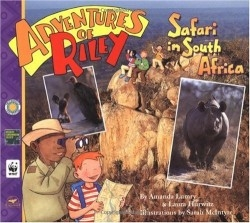Adventures of Riley
Safari in South Africa
The redheaded Riley is off for an adventure in South Africa with his “wild” Uncle Max, whose mission as a wildlife conservationist is to determine if various endangered species are increasing or decreasing. As soon as the safari leaves the camp the counting of young animals—and fun—begins.
What young reader will forget that cheetahs play a form of soccer using balls made of “elephant poop?” Or that the furry bushbabies, also called galagos, “pee on their hands and feet to help them grip tree branches when they jump and climb?” When Riley volunteers that piece of information, which he learned in school, his uncle says with a chuckle, “I hope that doesn’t give you any ideas.”
The kid-friendly text is interspersed with tidbits of information supplied from noted scientists from the Smithsonian Institution, the Wildlife Conservation Society, and World Wildlife Fund. Dr. Colleen McCann notes, for example, that the galago’s favorite food is grasshoppers, and that they have big eyes to help them see at night.
The illustrations are a visual adventure, combining real photographs and cartoon-style figures and settings. The page filled with a photograph of water buffalo, for example, shows the green cartoon jeep with Riley and the rest of the expedition inserted among them. This is Riley’s second adventure; the first was Tigers in Terai. The authors (Lumry is a photographer and Harvard graduate; Hurwitz is a writer who graduated from Yale) have also published books about the Cayman Islands, Nantucket, MalaMala, and an Amish and Mennonite community.
Besides the fun, there are many environmental lessons to be learned on Riley’s safari. Expedition members come across a rare black rhino, with a wound visible (this is a photograph). Uncle Max notes that the animal was probably injured by a poacher’s bullet. “This rhino was lucky to have gotten away,” he adds.
The tidbit box from Dr. George Amato, director of the Science Resource Center for the Wildlife Conservation Society, explains that the black rhinos are hunted for the reputed medicinal properties of their horns. Understanding the interest of his young readers, he offers this fact: “Black rhinos pee and poop on trails to let other rhinos know where they are and where they’ve been.” While there may seem like a lot of references to base functions of animals, it is the type of information often left out of children’s books, and is what they want to know.
Riley returns home to America, where he practices his tracking skills on neighborhood cats, while he awaits another letter from Uncle Max, detailing the next adventure in the series about environmental hotspots around the world.
Reviewed by
Linda Salisbury
Disclosure: This article is not an endorsement, but a review. The publisher of this book provided free copies of the book to have their book reviewed by a professional reviewer. No fee was paid by the publisher for this review. Foreword Reviews only recommends books that we love. Foreword Magazine, Inc. is disclosing this in accordance with the Federal Trade Commission’s 16 CFR, Part 255.

